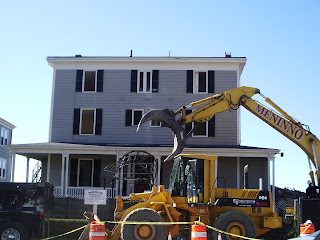Swampscott developed a flourishing resort hotel business beginning in the 1890’s. At one time there were eight hotels serving the summertime crowds that included U.S. Presidents Calvin Coolidge and John F. Kennedy, entertainers like Harpo Marx and Lucille Ball, and significant national figures such as Helen Keller, Billy Graham, and Sinclair Lewis. These grand establishments provided “the lavish hospitality, the health-giving charm of the out-door life” as well as “cool broad verandas, beautiful ballrooms, and an orchestra of the highest standard” (from an ad for the New Ocean House Hotel, 1907)
None of the large hotels remain standing today, most having been destroyed by fire or coastal storms. The last one, the New Ocean House, was probably the grandest, with a new wing that was reputed to be fireproof. It burned to the ground entirely in May, 1969, a conflagration old timers I’ve talked to still remember vividly.
 |
| New Ocean House Hotel |
Well, until this week, there actually was one remaining hotel, one of the earliest, a modest structure on Swampscott’s main shore road close to the center of town, Captain Jack’s Inn. Captain Jack’s was constructed in 1835, and for some residents represented the last remnant of Swampscott’s past glory as a seaside resort of national renown.
But the long time owner of Captain Jack’s sold it to a developer a while back who plans to build 15 condominiums on the oceanfront property. It took a bit under seven hours to reduce Captain Jack’s to a large pile of rubble. Trudi was across the street at Newman’s bakery buying Irish soda bread and hot cross buns as the heavy equipment chewed away at the Inn and reported several women sobbing at the sight of the destruction. No bells were ringing.
Shortly after we moved to Swampscott, I attended a public hearing on the fate of Captain Jack’s, and could see clearly the writing on the wall. While Swampscott has an Historical Commission, it turns out to have no tools beyond a “bully pulpit” to try to persuade developers to take historical significance of properties into account. Surprisingly, there is no Master Plan for the town, nor any Historic Districts as defined by Massachusetts law established within its boundaries. What I heard argued most forcefully at the hearing was that the owner and buyer were just following the spirit of capitalism, that something that is “old” isn’t always “historic”, and that those arguing for preservation should get out of the way of “progress”. And further that the new condominiums would bring in much needed tax revenue to pay for schools and police.
And so, in the name of progress and the right to profit, Captain Jack’s is no more. As a newcomer to the town, I can’t really claim authentic nostalgia for its past. But it saddens me to see such a turn of events, and to imagine with dread what other pieces of Swampscott’s historic character will be next in line for obliteration.


